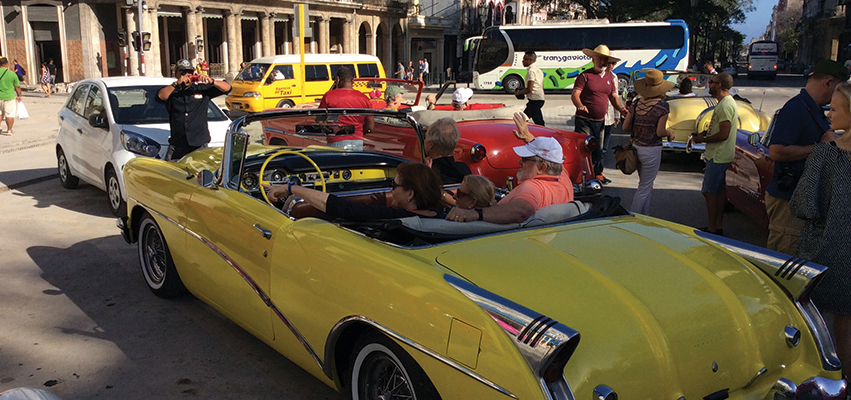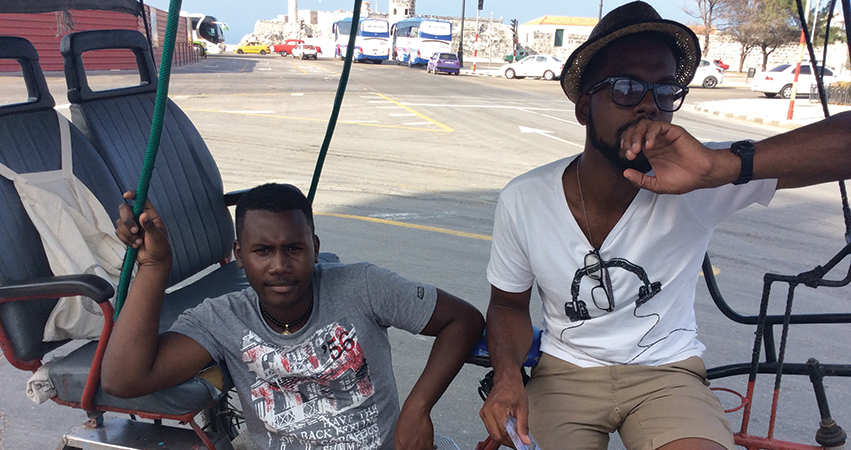Notes from a visit to a fast-changing country, buoyed by its resilient, creative, joyful population
As I prepared to visit Cuba this past March, I was a bit apprehensive. It was just two weeks before President Obama’s visit: How would Cubans feel about Americans?
The Cuban economy had been compromised by embargoes: How would this affect their hotels and restaurants—and the safety of their food and water?
I would have to do without my omnipresent cellphone: How would I adjust?
Luckily, my curiosity was stronger than my concerns, and I wholeheartedly enjoyed my experience on the University of Wisconsin’s “People to People” trip to Cuba. At that time, the only way for U.S. citizens to visit Cuba was through People to People programs—educational trips designed to present a culture and way of life, beyond the tourist attractions. There were 32 of us—travelers of various ages, careers and hometowns.
It was an eight-day introduction to a most amazing people and their island nation, beginning with our eloquent guide, Jorge Perez, an educator and Cuba native with a daughter in Miami, and our cosmopolitan tour director, Natalia Makorova, a Russian woman who spent her early years in Cuba and returned later as a young adult.
To set the stage for this experience, it’s helpful to know that in some ways, the history of Cuba and its relationship to Europe mirrors the U.S. experience, albeit with some stark contrasts. The island was “discovered” by Columbus in the 1490s; a century later, the native population was decimated by diseases brought by the Spanish.
The Spanish and British were the major colonial influences, with the British occupying Havana in the late 1700s, influencing trade routes and running a large slave trade. Until the practice was finally abolished, African slaves harvested sugar cane and built Cuba’s extensive railroad system, and their descendants comprise a significant portion of the population today. There was also considerable trade with North America—many of Cuba’s cobblestone streets were built using the ballast carried by American ships.
The Cubans are a strikingly attractive, multicultural people, and their religious identity is also complex. All faiths are welcome, but the largest religious practice is a combination of African religions and Catholicism called Santeria. While visiting a Santeria center of worship in Trinidad, our guide translated the words of their spiritual leader to describe some of their beliefs: They honor a black Mary and a white Jesus, and believe in heaven, but believe that hell is experienced on earth, not in the afterlife.
The Revolution
In 1953, Fidel Castro began his attempts to take over Cuba, but it wasn’t until the end of 1958 that he and his ragtag group of revolutionaries were successful. Former President Batista fled the country without putting up much of a fight; the revolution had been fermenting for some time—and he had money stashed overseas.
While touring Batista’s former residence, now the Museum of the Revolution, one sees bullet holes throughout—evidence of the violent takeover. And though Castro led the group that overtook the country, the person most celebrated by the people of Cuba, as it would appear from monuments and statues, is the Argentine guerrilla leader, Che Guevara—some say because he is the one who died.
Private business flourished under Batista’s rule, as did a flamboyant, Vegas-like entertainment and gambling environment, complete with high-placed corruption and mob investments. Castro closed the casinos and established state ownership of most businesses, resulting in the flight of doctors, lawyers, entrepreneurs and other middle-class professionals, many of whom immigrated to Florida. Everything in Cuba was run by the state—that was the revolution’s most far-reaching effect.
A variety of influences followed, most notably Soviet Communism, and Cuba’s economy suffered. Perhaps most difficult was the period in the 1980s after Castro sent his most dangerous prisoners to the U.S., resulting in the imposition of extremely restrictive embargoes. When the Soviets abandoned Cuba, the economy entered a deep depression, referred to by Cubans as the “Special Period.” (As an American, one can’t help but marvel at this term, for we would have labeled it a “great depression” or “economic disaster.”) Most families pieced together various moneymaking options to support themselves: working for the government, exchanging services for pesos, or accepting goods to sell on the black market from family in other countries.

The Cuban Economy
Today, though the state provides a minimal allowance for each citizen to pay for basic food and housing, it’s not enough for a living wage. And while it promises every college graduate a job, many Cubans seek work outside of the state-run organizations. Entrepreneurship is growing, and even many state workers have an entrepreneurial source of income on the side.
It quickly became apparent to our group that the finest dining experiences were at the privately run restaurants for their unique, deliciously prepared food—very different from the predictable state-run facilities. While nationalized stores and factories remain the norm, the influence of capitalism is becoming more visible, especially in tourist areas.
The existence of dual currencies contributes to the mystery surrounding the Cuban economy. The Cuban peso is used for everyday transactions among ordinary Cubans, but the government issues another currency—a “convertible peso,” or CUC—which is used by most tourists. The exchange rate is 87 cents per CUC after exchange fees—U.S. citizens must convert their dollars so the government gets its surcharge.
Though sugar cane is no longer as important, Cuba’s cigar industry continues to flourish, using the signature handmade process that made it internationally renowned. In the early years of the revolution, readers were employed to keep the factory workers engaged by reading newspapers and literary works, like Shakespeare, while music was played by local musicians. Today, while some factories still employ readers, there is less of that cultural emphasis—though some cigar brands bear the names of Shakespearean characters.
A Tourist’s Welcome
Along with tours of several schools, a home for the aged, Hemingway’s home, religious organizations and a factory, our group was privileged to attend a number of excellent lectures. University of Havana Professor Jorge Mario Sánchez told us that as much as Cubans look forward to an improved economy with an influx of U.S. tourists, they are concerned about maintaining their quality of life. They fear overbearing American influence and are not ready to welcome a Starbucks on every corner, nor do they want to give up their private restaurants for chains. They simply want a normal, mutually respectful relationship—and tourism appears to be the hope for the future.
To be sure, the friendliness of the Cuban people made us feel quite welcome. As you observe the people in public streets and squares, there is a sense of joyful interaction. It was not unusual for my friend and me to be greeted with “Hello, North American ladies,” as we walked the boulevards of Havana or took a ride in a 1955 Chevrolet convertible/taxi.
Miguel Coyula, a Cuban architect and urban planner, lectured on the complexities of updating cities—especially in an economy incorporating both capitalism and communism. For example, one of the legacies of the Batista era is an art deco style of architecture that dominates Havana’s major buildings. Many have fallen into disrepair, and the effort is to update the buildings’ interiors, while maintaining the beauty and character of the facades.
The streets are safe and the scenery beautiful, but you need to watch where you walk, as the roads everywhere are torn up to make way for internet-ready infrastructure improvements. The Cubans are frustrated with their lack of internet accessibility. (Some in our group purchased special access and found it unreliable; I decided to focus on the experience and not even try.) In addition, basic products like toilet paper are in short supply, so come ready with coins to tip the attendants. The hotels have supplies—though not always air conditioning or hot water.
Education, Medicine and the Arts
While it’s obvious that most Cubans live in modest apartments or homes, it’s also apparent that they have access to nutritious food, and that children are valued and educated. It is not always an easy life, but the Cubans are problem solvers and look for the joys in life—in music and art, fellowship and romance.
The literacy rate hovers around 97 percent, and the arts are an important part of Cuban culture. Live music is a staple in restaurants and hotels—the hot water might be iffy, but the Vivaldi performed by a string quartet at breakfast sets a beautiful tone for the day.
We visited a number of drama, music and arts programs, including Habana Compás Dance, which combines traditional Spanish flamenco with Afro-Cuban rhythms. We also toured a private technical trade school founded by three women who saw the need for skills training in the building trades, and walked the campus of the University of Havana. Founded in 1778, it has 14,000 students—65 percent of them women—with colleges of sciences, humanities, medicine and law.
High-quality medical care is one of Cuba’s major success stories—and a key economic export. Teams of their doctors visit countries around the world, often for profit, and other times for humanitarian reasons—such as treating the Ebola epidemic, where Cuba was among the first to help.
All Cubans have access to medical care, which is community-centered. In Havana, you will find doctors living in the neighborhood—using the first floor of their home for their practice, and the second for their family residence. And their familiarity with their patients can make a huge difference in the quality of care; they are aware if children are not brought in for vaccinations, for example, and they offer comprehensive prenatal care.
In addition to the neighborhood practices, a centrally located medical center offers hospital and emergency room services. Though computers are rare, meticulous records are maintained and outcomes measured to indicate the results of treatments—the efficacy of which is apparent in Cuba’s long life expectancies.
Five of our 32 participants experienced Cuban physicians firsthand, as they had tough cases of the local variety of “tourista.” All recovered fully, but it is important to avoid the local water and follow the guide’s advice on what local produce is safe.

The “Real” Cuba
As a traveler, you have certain preconceptions. Videos on YouTube of life in Cuba do not seem compatible with the notion of visiting a Communist country, but the “real” Cuba is so much more complex, interesting and exciting than either scenario. You might think you will be in a third-world country, and there are instances of that. But the Cuban people are warm, welcoming and joyous, with a great appreciation for all types of art—and life itself. One can’t help but find this vitality and engagement inspiring.
In March, Cuba was awash with sunshine, the blue sky and beauty of its blossoms, buildings and people dissipating any sense of extreme poverty. Still, as I write this, dark clouds of the Venezuelan oil crisis hang over the island nation, threatening its energy supply. Yet somehow, the Cuban people will find a way around this dilemma, as they have so many times before. a&s


